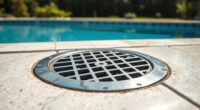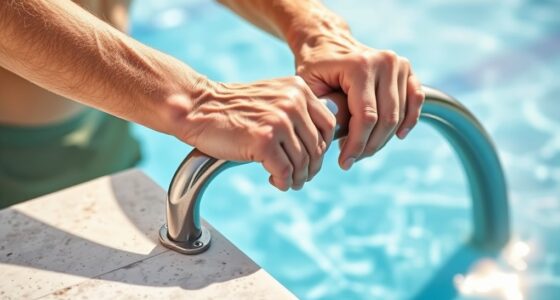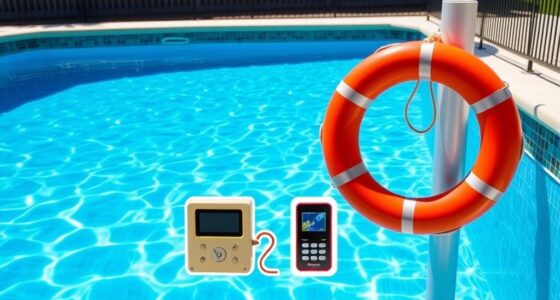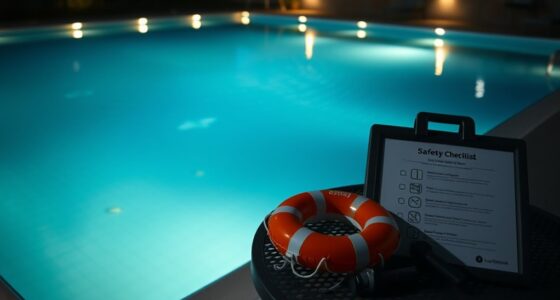Dual main drains provide multiple outlets for water flow, reducing suction and lowering entrapment risks, especially in larger or commercial pools. Safety vacuum-release systems automatically respond to pressure buildup and blockages, quickly shutting off suction and preventing injuries. While dual drains improve circulation and offer redundancy, vacuum-release devices provide targeted safety features. For a complete understanding of how these systems work together and which might suit your needs best, keep exploring further.
Key Takeaways
- Dual main drains provide redundancy and distribute water flow, reducing entrapment risk and improving circulation.
- Safety vacuum-release systems automatically release pressure during blockages, preventing vacuum hazards and entrapment.
- Dual drains require more maintenance and inspection but enhance overall safety through multiple water outlets.
- Vacuum-release systems are simpler, cost-effective, and easier to maintain, ideal for smaller or less complex pools.
- Combining both systems offers the highest safety level, ensuring redundancy, pressure regulation, and compliance with safety standards.
How Dual Main Drains Work to Prevent Entrapment

Dual main drains are designed to considerably reduce the risk of entrapment by providing multiple outlets for water flow. When one drain becomes blocked or clogged, the second drain ensures continuous water circulation, preventing suction from becoming dangerously strong. This setup minimizes the chances of a person’s body, hair, or limbs getting trapped by creating alternate pathways for water to escape. By distributing water flow across two outlets, dual main drains decrease the pressure exerted on anyone in the pool or spa. They also help maintain proper water circulation, reducing the risk of hazardous suction forces. Additionally, automation technology in modern pools can monitor drain function and alert operators to potential issues, further enhancing safety. Proper drain design is essential in ensuring these systems function effectively and safely. Modern drain systems also incorporate advanced safety features to further prevent entrapment and improve overall pool safety. To ensure these safety measures are effective, compliance with safety standards is crucial in the design and installation of drain systems. Overall, this design enhances safety by limiting the likelihood of entrapment, giving you peace of mind while enjoying the pool.
The Functionality of Safety Vacuum-Release Systems

Safety vacuum-release systems work by regulating pressure to prevent entrapment, ensuring the water flow stays balanced. When excess pressure builds, the system releases air to maintain safe conditions. This air release process helps keep swimmers safe by avoiding dangerous vacuum buildup. Additionally, proper maintenance of these systems, including checking for system integrity, is crucial to ensure ongoing safety. Regular inspections can help identify and address potential issues before they compromise performance. Staying informed about the latest cybersecurity vulnerabilities related to pool systems can assist in preventing cyber threats that may target safety features. Furthermore, ongoing monitoring of AI safety measures can enhance the reliability and security of modern pool safety technologies. Incorporating preventative maintenance practices ensures these systems operate effectively over time.
Pressure Regulation Mechanism
The pressure regulation mechanism in vacuum-release systems works by automatically releasing excess air or water pressure to maintain a safe and stable environment within the pool’s drainage system. When pressure builds up unexpectedly, this system activates, preventing dangerous vacuum conditions. It’s like having a vigilant guardian that keeps everything balanced, giving you peace of mind. Imagine the relief of knowing your loved ones are protected from potential suction hazards. The table below highlights how this mechanism responds during critical moments:
| Pressure Level | Activation Response | Resulting Safety |
|---|---|---|
| Normal | No action | Stable operation |
| Excessive | Releases pressure | Prevents vacuum |
| Critical | Rapid relief | Ensures safety |
| Overload | System overload alert | Immediate action |
| Emergency | Fully releases pressure | Maximum safety |
Additionally, understanding industry standards and best practices can help optimize the safety features of these systems for improved protection. Recognizing the importance of pressure regulation and the drainage system’s design helps ensure these systems perform reliably under various conditions, further enhancing safety.
Air Release Process
An essential part of vacuum-release systems is how they manage air to prevent dangerous pressure buildup. When a vacuum forms in the pool, the safety vacuum-release system automatically detects the pressure drop. It then opens a vent or release valve, allowing air to enter the system. This influx of air equalizes the pressure, preventing structural damage or implosion risks. The process is quick and automatic, ensuring safety without user intervention. The system’s design ensures that air is released smoothly without creating turbulence or disturbing the pool’s flow. By controlling pressure levels effectively, the air release process maintains the system’s integrity and safety standards. Proper maintenance and timely inspection are crucial to ensure the system functions correctly and reliably for optimal safety. Regular testing of these systems is recommended to ensure they respond appropriately during an emergency and comply with safety regulations. Additionally, understanding the importance of system reliability can help prevent potential failures and enhance overall safety. Incorporating preventative maintenance procedures can further reduce the risk of system malfunctions. Moreover, advancements in sensor technology continue to improve the precision and responsiveness of these safety mechanisms. This automatic venting mechanism is critical for protecting both pool users and the pool structure itself.
Compliance With Pool Safety Regulations and Standards

Ensuring your pool complies with safety regulations and standards is essential to prevent accidents and meet legal requirements. You need to familiarize yourself with local and national codes, such as the Virginia Graeme Baker Pool & Spa Safety Act, which mandates specific safety features. Regular inspections help verify that drain covers are compliant, properly installed, and in good condition. Using approved drain covers and safety vacuum-release systems reduces entrapment risks. Keep detailed records of inspections, maintenance, and safety system updates. Staying current with evolving standards guarantees your pool remains compliant and safe for users. Implementing safety measures can further enhance overall safety and prevent potential hazards. Non-compliance can lead to hefty fines, lawsuits, or even pool closures. Prioritizing safety standards protects your guests and ensures your pool remains a safe recreational space.
Advantages of Dual Main Drains in Pool Safety
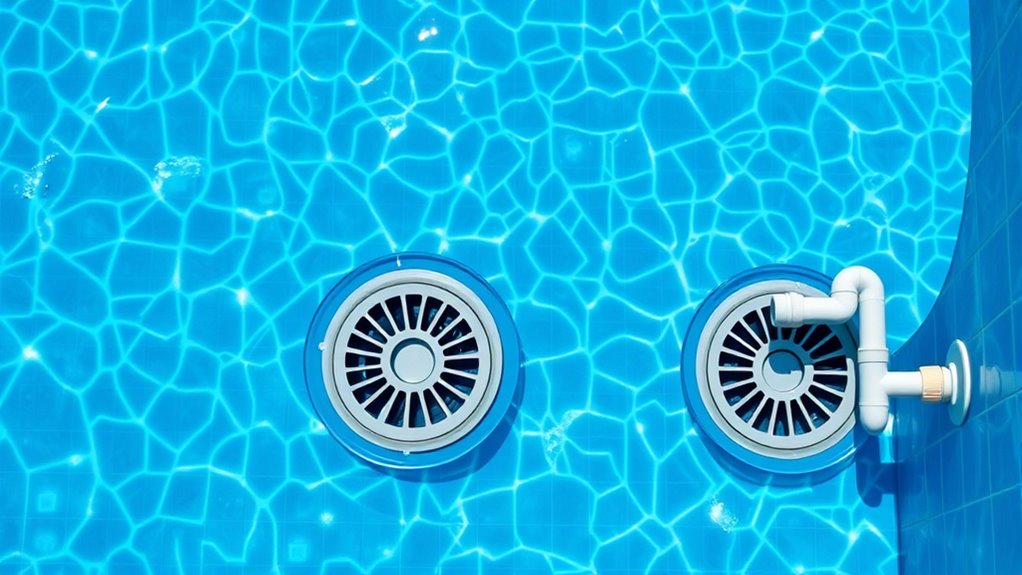
With dual main drains, you add a redundant safety layer that helps prevent suction accidents. They also improve circulation, keeping the water cleaner and safer. These features make dual main main drains a smart choice for pool safety. Additionally, incorporating environmentally conscious practices during installation can further enhance safety and sustainability. Proper design considerations can help minimize hazardous conditions associated with pool operation, ensuring a safer swimming environment for all. Embracing creative problem-solving in the design process can lead to innovative safety solutions that adapt to various pool settings. Moreover, understanding the sound healing science behind certain safety installations can inspire more effective and harmonious pool safety systems.
Redundant Safety Layer
Dual main drains create a crucial safety buffer by providing a redundant layer that reduces the risk of entrapment if one drain becomes blocked or malfunctioning. If debris or hair blocks one drain, the second drain ensures continuous water flow, preventing dangerous pressure buildup. This setup minimizes the chance of a swimmer getting trapped or injured due to a single point of failure. Having two drains connected to separate pump systems means that even if one system fails, the other maintains safety. This redundancy acts as a fail-safe, giving you peace of mind knowing there’s an extra barrier against accidents. Fundamentally, dual main drains markedly improve pool safety by adding an extra layer of protection, reducing the likelihood of entrapment incidents and enhancing overall security.
Enhanced Circulation Efficiency
Having multiple main drains not only adds a safety buffer but also considerably improves water circulation within the pool. Better circulation helps prevent stagnant areas, ensuring the entire pool stays clean and clear. With more drains working simultaneously, water moves more efficiently through the filtration system, reducing debris buildup and improving chemical distribution. This enhanced flow helps maintain consistent temperature and water quality, making your pool safer and more inviting. You’ll notice quicker clearing of particles and fewer dead zones where algae and bacteria can thrive. Proper circulation also minimizes strain on the pump, increasing its lifespan.
- Reduces dead spots that trap debris
- Promotes uniform chemical distribution
- Improves overall water clarity
- Enhances filtration efficiency
Benefits of Safety Vacuum-Release Systems for Swimmers
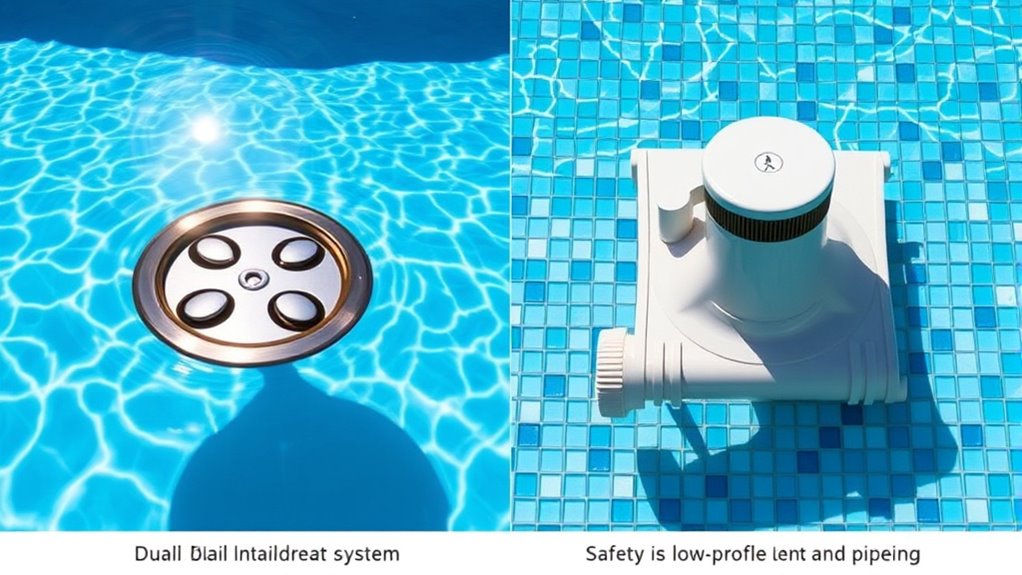
Safety vacuum-release systems offer crucial benefits by reducing the risk of entrapment and injury during pool emergencies. These systems automatically shut off suction if a blockage or entrapment occurs, preventing swimmers from being held underwater or injured. This quick response minimizes panic and potential drowning hazards, especially for children or inexperienced swimmers. Additionally, safety vacuum-release systems help pool operators comply with safety standards, showing a commitment to swimmer protection. They also reduce the likelihood of suction-related injuries caused by hair, jewelry, or body parts getting caught. By providing an extra layer of safety, these systems foster a safer swimming environment, giving you peace of mind knowing that emergency situations are better managed and the risks of entrapment are markedly lowered.
Comparing Maintenance and Reliability of Both Systems

When it comes to maintenance and reliability, safety vacuum-release systems generally require less upkeep because they have fewer moving parts and are designed for straightforward testing and inspection. They’re built to be simple and durable, reducing the chance of mechanical failure over time. In contrast, dual main drain systems often need more regular checks to ensure proper operation, especially around pipe connections and drain covers.
- Safety systems typically need annual testing, with minimal adjustments.
- Dual main drains may require inspections for leaks or blockages.
- Vacuum-release systems are less prone to clogging or mechanical breakdown.
- Dual drains involve more components, increasing potential points of failure.
Making an Informed Choice for Your Pool Safety Needs

Choosing the right pool safety system involves evaluating your specific needs, budget, and willingness to perform regular maintenance. If you prioritize ease of maintenance and affordability, a safety vacuum-release system might suit you better. It’s simple to install, requires minimal upkeep, and effectively prevents entrapment hazards. On the other hand, if you want a more robust solution with redundancy, dual main drains could be the better choice, especially for larger or commercial pools. Consider your pool size, usage frequency, and local safety regulations. Also, think about long-term costs and safety features. Making an informed decision means researching each system’s benefits and limitations, consulting professionals, and aligning your choice with your safety priorities and budget constraints. Your goal is to ensure maximum safety with a system that fits your pool and lifestyle.
Frequently Asked Questions
Can Dual Main Drains and Safety Vacuum-Release Systems Be Used Together?
You can definitely use dual main drains and safety vacuum-release systems together. Combining these systems enhances pool safety by reducing the risk of entrapment and ensuring proper water flow. Dual drains help prevent suction hazards, while vacuum-release systems automatically activate if a vacuum lock occurs. Installing both provides a thorough safety setup, giving you peace of mind knowing that potential dangers are minimized and your pool remains safe for everyone.
What Are the Cost Differences Between Installing Dual Main Drains and Safety Vacuum-Release Systems?
You want to know the cost differences between installing dual main drains and safety vacuum-release systems. Generally, dual main drains tend to be less expensive upfront since they involve adding an extra drain line, which can range from a few hundred to over a thousand dollars depending on pool size. Safety vacuum-release systems may cost more initially, typically between $300 to $600, but they offer enhanced safety features, making the investment worthwhile.
How Long Do Safety Vacuum-Release Systems Typically Last Before Replacement?
You’re wondering how long safety vacuum-release systems last before needing replacement. Typically, these systems can last 10 to 15 years, but their lifespan depends on factors like usage, maintenance, and environmental conditions. Regular inspections and proper upkeep can extend their durability. Keep an eye out for signs of wear or damage, and consult a professional to ensure your safety systems remain fully functional over time.
Are There Specific Pool Sizes or Types That Benefit More From These Systems?
You’re wondering if certain pool sizes or types benefit more from safety vacuum-release systems. Larger pools or those with complex plumbing often gain extra safety and peace of mind from these systems, especially in commercial settings. Small residential pools usually don’t need them as much, but if your pool has multiple drains or unusual design features, installing a safety vacuum-release system can help prevent dangerous vacuum buildup, ensuring safer swimming for everyone.
What Maintenance Is Required to Ensure Both Systems Function Properly?
To keep your pool safe, you need regular maintenance on both systems. You should inspect the drain covers for cracks or damage and clean out any debris that could clog the system. Check the vacuum-release valves and fittings for leaks or corrosion, and verify the pressure is within recommended levels. Regularly testing the system’s functionality and scheduling professional inspections will help ensure both systems operate smoothly and safely.
Conclusion
Ultimately, understanding the strengths and safeguards of dual main drains and safety vacuum-release systems helps you make smarter, safer swimming decisions. By balancing boldness with backup, you build a barrier against accidents and ensure blissful, barrier-free enjoyment. So, prioritize protection, pick the proper system, and promote peace of mind for everyone in your pool. Remember, safety starts with smart systems, so stay vigilant, vigilant, and vigilant to keep every splash safe and sound.

